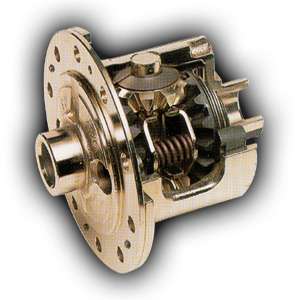The MGA With An Attitude
The clutch type LSD has all of the same components as an open differential, but it adds a spring pack and a set of clutches. Some of these use flat disc clutches while others use a cone clutch similar to a synchronizer in a manual transmission. In the picture here you can see a central spring pack and clutch discs outboard of the sun gears.
This looks good if you have one wheel on ice, as the wheel with better traction will get more torque than the spinning wheel by the amount of torque in the clutch pack. With enough spring force the one wheel could accept all of the available propshaft torque in the lowest gear, or as much torque as it will take to spin the tire (whichever is less). Since most cars can spin the tires in low gear (with a heavy flywheel and jack rabbit start), that would dictate the maximum spring force to be used. The torque supplied to the wheel not on the ice is equal to the amount of torque it takes to overpower the clutches. The result is that you can move forward, although still not with the full power of your car. There are some problems with this approach. When you are in a turn the outside wheel wants to turn faster than the inside wheel. The clutch type differential then applies more torque to the inside wheel, which is already lighter at speed due to some body roll. The inside wheel might then slip and spin a bit until it is turning as fast as the outside wheel. This small amount of slippage may reduce driving traction at the tire thereby reducing overall driving thrust. It might also reduce lateral grip of the slipping tire increasing tendency for side slip. The important idea here is that the LSD should prevent the inside wheel from spinning wildly with low traction, even if it is off the ground. When pushing the car to the limits of grip and acceleration in a turn, the inside wheel attempting to turn faster than it's natural tracking speed will tend to push the car in a straight line, inhibiting the ability to turn in and make it around the corner. This induces understeer which would force you to slow down to stay in the road. Alternately you might adjust the suspension to produce more oversteer to compensate. Then you may end up with too much oversteer while taking a corner with light throttle or off throttle. This tendency for a friction clutch type LSD to affect oversteer or understeer on the fly is a bit of a compromise (trade off) for attaining the limited slip character. |
